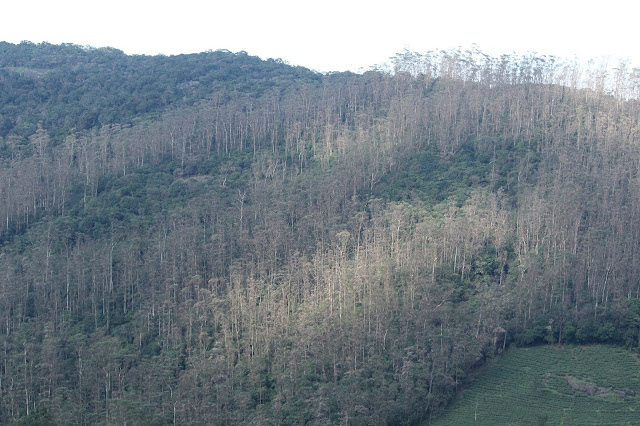Whiter eucalyptus!
Whiter eucalyptus!
Ganesh T
The monsoon weather is now slowly on its way out
even though the cloud and mist still cover the mountains of the Agasthyamalai.
The new year began for the phenology team with a visit to the Manjolai and
Kodayar forests for their monthly phenology. My visit to ACCC
coincided with their trip and what better thing to do but accompany them into
the mountains. The lushness of the monsoons was visible everywhere. The forests were dark and green, the streams were rumbling
through with sparkling waters, dams were full, roads were bad and weather
perfect to be outdoors.
As we moved to the higher elevations and entered
the Manjolai estates, there was something strange about these
hills. The hills around Manjolai are usually clothed in dense
evergreen forests on one side and extensive plantation of eucalyptus donning
the east-facing slope. These hill slopes with the plantations looked distinctly
brown with eucalyptus leaves drying up while still on the tree. The entire plantation
was affected and only a few patches were left intact. The attack on the leaf
was mostly at the middle and bottom of the tree while the top few branches
still had green leaves. Further up we saw a few trees similarly affected up to
Nalmukh but did not see such an impact in Kodayar.
A similar episode of mass drying of leaves was noticed in early 2000 but it was not this extensive and
trees in the higher elevations were not affected. It was also very patchy and I
remember they had recovered after this drying. Maybe these will also,
but what caused such drying will be interesting to know.
 |
| Pic credit: Thalavai pandi S |
In the earlier drying also we could not ascertain
what caused it but in forest diebacks where many trees suddenly die in an area
and that had happened earlier, we found evidence of fungs in the rotting wood.
But those trees were dead unlike now where the trees are alive. Maybe it’s an
initial stage of a Dieback? Or is it something else? Are the plants in the
stage of recovering from the effect or it’s just a beginning? Last month the
phenology team did not see such an impact or did they miss it? Was
this due to an increase in moisture levels this year because of continuous rain
in the hills from May last year? As usual, many questions will be asked but
fewer answers would emerge as is the norm for such large scale phenomena.
Notes
The TNEB that controls the upper Kodayar
dam and the power grid passing through the forest has initiated a long-pending
mission to replace the rusting pylons and cables. These have always posed a
great danger to people and animals in the area. I do not remember seeing these
lines changed in the last 30 years except that they were regularly painted
until the last decade after which the weather has taken its toll on the metal
very quickly. The road to Kodayar is lined with new metal bars and cables that
would be dragged and erected amidst the jungle over the next 6 months before
the next monsoon sets in.


Comments
Post a Comment